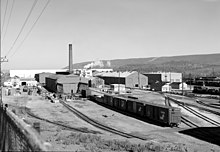Altoona, Pennsylvania
| Altoona | ||
|---|---|---|
 View of Altoona Downtown |
||
| Location in Pennsylvania | ||
|
|
||
| Basic data | ||
| Foundation : | 1849 | |
| State : | United States | |
| State : | Pennsylvania | |
| County : | Blair County | |
| Coordinates : | 40 ° 31 ′ N , 78 ° 24 ′ W | |
| Time zone : | Eastern ( UTC − 5 / −4 ) | |
|
Inhabitants : - Metropolitan Area : |
44,589 (as of 2016) 124,650 (as of 2016) |
|
| Population density : | 1,762.4 inhabitants per km 2 | |
| Area : | 25.3 km 2 (approx. 10 mi 2 ) | |
| Height : | 368 m | |
| Postcodes : | 16601, 16602, 16603 | |
| Area code : | +1 940, 941, 942, 943, 944, 946, 947, 949 | |
| FIPS : | 42-02184 | |
| GNIS ID : | 1192069 | |
| Website : | www.altoonapa.gov | |
| Mayor : | Matthew A. Pacifico (since 2013) |
|
Altoona is a city in Blair County , Pennsylvania , United States that had a population of 46,321 according to the 2010 census . It is located in the Allegheny Mountains and is the ninth largest city in this state in terms of population. Like hardly any other city in the USA, its history was largely shaped by the railroad.
history
Before the first settlers reached the region around Altoona around 1700, the area was inhabited by Indians from the Iroquois tribe.
When choosing a cheap route for a railway line from the east coast to Pittsburgh over the Allegheny Mountains, the Pennsylvania Railroad (PRR) decided to choose Altoona as an important station on the route to overcome the mountain range at a convenient point. Altoona was founded in 1849 and registered on February 6, 1854 as a municipality with more than 2000 inhabitants. Due to the strong growth of the city, the municipality received city rights as early as 1868 . The Logan House became the most famous building in the city. In addition, extensive depots were created, which also served as locomotive factories, with the Altoona locomotive workshop becoming the fourth largest locomotive manufacturer in the United States.
In 1880, the local horse-drawn tram started operating, electrified in 1891 and operating as the local tram under the name The Altoona and Logan Valley Electric Railway until September 7, 1954.
The considerable influence of the railroad on urban development, with the slow decline of this mode of transport in the second half of the 20th century, led to the decline of local businesses and required major structural changes. The Lokomotivwerke produced their last locomotive in 1946. In 1990 Altoona was connected to the Interstate trunk road network with connections to Interstate 80 and Interstate 99 .
Attractions
New shopping districts and educational institutions such as Penn State Altoona , a campus of Pennsylvania State University , have sprung up in the city center . The sights still preserved today include the Mishler Theater , the town hall and the cathedral . Altoona is still a popular destination for railroad enthusiasts from all over the world.
The Railroaders Memorial Museum commemorates the importance of the railroad in Altoona. About eight kilometers west of the city is the famous Horseshoe Curve (horseshoe curve), a 220-degree curve on the east ramp of the PRR main line, which leads here in a very curved route over the Allegheny Mountains and is a popular destination for railroad fans . It was built in 1854 and added to the list of historical milestones in engineering in 2003.
Others
The Roman Catholic diocese Altoona-Johnstown was established in 1901 and has its seat in Altoona. Episcopal Church is the Cathedral of the Blessed Sacrament, built from 1924 to 1960 in neo-baroque style .
The Altoona Mirror newspaper, published since 1876 , now has a circulation of 32,000 copies.
The local baseball club is called Altoona Curve .
The regional airport Altoona Blair County Airport ( IATA : AOO , ICAO : KAOO ) has connections to Washington, DC and Pittsburgh . The airport is located about 19 kilometers south of Altoona in the town of Martinsburg.
See also : Local Transportation in Altoona, Pennsylvania
Town twinning
Personalities
- Gertrude Woodcock Seibert (1864–1928), poet and eminent Bible scholar
- Frank R. Strayer (1891–1964), film director and producer
- Harry J. Anslinger (1892–1975), diplomat and chairman of the Federal Bureau of Narcotics
- H. Beam Piper (1904-1964), science fiction writer
- Janet Blair (1921–2007), film and television actress
- Jon Eardley (1928-1991), jazz trumpeter
- Henry Kloss (1929-2002), designer
- Stan Jones (1931-2010), American football player and coach
- Paul Winter (* 1939), saxophonist and band leader
- Ronald Smelser (* 1942), historian
- John Pielmeier (* 1949), screenwriter and actor
- Michael J. Behe (* 1952), biochemist
- Charlie Crist (* 1956), politician
- John Joyce (born 1957), politician
- Andrew Kevin Walker (born 1964), screenwriter
- Danah Boyd (* 1977), media scientist and social researcher
- Brian Sell (* 1978), long-distance runner
Web links
proof
- ^ City website , accessed October 16, 2017





